學習筆記--第三週
2020-09-28 11:00:22
本週Android學習總結
activity生命週期
測試:
在MainActivity.java中寫入如下程式碼
public class MainActivity extends AppCompatActivity {
private static final String TAG = "life_cycle";
@Override
protected void onCreate(Bundle savedInstanceState) {
super.onCreate(savedInstanceState);
setContentView(R.layout.activity_main);
Log.d(TAG, "onCreate invoked. (建立)");
}
@Override
protected void onStart() {
super.onStart();
Log.d(TAG, "onStart invoked. (已開始)");
}
@Override
protected void onResume() {
super.onResume();
Log.d(TAG, "onResume invoked. (已恢復)");
}
@Override
protected void onPause() {
super.onPause();
Log.d(TAG, "onPause invoked. (暫停)");
}
@Override
protected void onStop() {
super.onStop();
Log.d(TAG, "onStop invoked. (已停止)");
}
@Override
protected void onRestart() {
super.onRestart();
Log.d(TAG, "onRestart invoked. (已重新啟動)");
}
@Override
protected void onDestroy() {
super.onDestroy();
Log.d(TAG, "onDestroy invoked. (釋放資源)");
}
}
點選左下角第四個按鈕logcat,在最右邊的下拉框中選擇Edit Filter Configuration
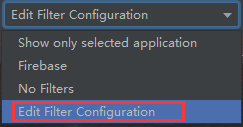
選擇按標籤過濾並寫入標籤名,下面選擇debug
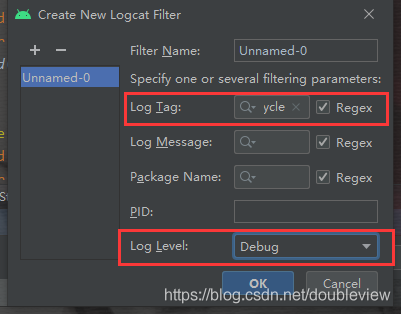
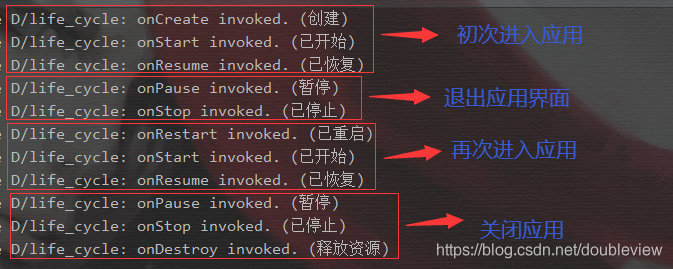
生命週期這一塊並沒有完全弄懂,使用者在恢復和暫停期間可以互動這些也很好理解,但是總覺得漏了點什麼;這方面的應用倒是見過不少,比如某大砍刀購物軟體,你幫別人砍刀之後再退出的時候總是有一堆彈窗跳出來,這應該是在呼叫關閉應用那幾個回撥方法的時候設定的吧(個人理解)。
視窗跳轉(攜帶資料)
首先編寫首頁,注意在需要攜帶資料的地方和跳轉按鈕新增id屬性
<?xml version="1.0" encoding="utf-8"?>
<LinearLayout xmlns:android="http://schemas.android.com/apk/res/android"
xmlns:app="http://schemas.android.com/apk/res-auto"
xmlns:tools="http://schemas.android.com/tools"
android:layout_width="match_parent"
android:layout_height="match_parent"
android:orientation="vertical"
android:gravity="center"
android:padding="15sp"
android:background="@drawable/bk012"
tools:context=".LoginActivity">
<TextView
android:id="@+id/tvUserLogin"
android:layout_width="wrap_content"
android:layout_height="wrap_content"
android:text="@string/user_login"
android:textColor="#ff00ff"
android:textSize="25sp"/>
<LinearLayout
android:layout_width="wrap_content"
android:layout_height="wrap_content"
android:gravity="center_horizontal"
android:orientation="horizontal"
android:layout_marginBottom="30dp">
<TextView
android:id="@+id/tvUsername"
android:layout_width="wrap_content"
android:layout_height="wrap_content"
android:text="@string/username"
android:textColor="#000000"
android:textSize="20sp" />
<EditText
android:id="@+id/edtUsername"
android:layout_width="wrap_content"
android:layout_height="wrap_content"
android:hint="@string/input_username"
android:ems="10"
android:singleLine="true"/>
</LinearLayout>
<LinearLayout
android:layout_width="wrap_content"
android:layout_height="wrap_content"
android:gravity="center_horizontal"
android:orientation="horizontal">
<TextView
android:id="@+id/tvPassword"
android:layout_width="wrap_content"
android:layout_height="wrap_content"
android:text="@string/password"
android:textColor="#000000"
android:textSize="20sp" />
<EditText
android:id="@+id/edtPassword"
android:layout_width="wrap_content"
android:layout_height="wrap_content"
android:hint="@string/input_password"
android:inputType="textPassword"
android:ems="10"
android:singleLine="true"/>
</LinearLayout>
<LinearLayout
android:layout_width="wrap_content"
android:layout_height="wrap_content"
android:gravity="center_horizontal"
android:orientation="horizontal">
<Button
android:id="@+id/btnLogin"
android:layout_width="wrap_content"
android:layout_height="wrap_content"
android:paddingLeft="30dp"
android:paddingRight="30dp"
android:background="@color/danlv"
android:textColor="#ffffff"
android:text="@string/login"
android:layout_marginRight="10dp"
android:textSize="20sp"/>
<Button
android:id="@+id/btnCancel"
android:layout_width="wrap_content"
android:layout_height="wrap_content"
android:paddingLeft="30dp"
android:paddingRight="30dp"
android:background="@color/danlv"
android:text="@string/cancel"
android:textSize="20sp"
android:textColor="#ffffff"/>
</LinearLayout>
</LinearLayout>
之後編寫對應的Java頁面(註釋很清楚)
public class LoginActivity extends AppCompatActivity {
private EditText edtUsername;
private EditText edtPassword;
private Button btnLogin;
private Button btnCancel;
@Override
protected void onCreate(Bundle savedInstanceState) {
super.onCreate(savedInstanceState);
setContentView(R.layout.activity_login);
//活動欄圖示
ActionBar actionBar = getSupportActionBar();
actionBar.setDisplayShowHomeEnabled(true);
actionBar.setDisplayUseLogoEnabled(true);
actionBar.setLogo(R.mipmap.ic_launcher);
//獲取控制元件範例
edtUsername = findViewById(R.id.edtUsername);
edtPassword = findViewById(R.id.edtPassword);
btnLogin = findViewById(R.id.btnLogin);
btnCancel = findViewById(R.id.btnCancel);
//給登入按鈕註冊監聽器
btnLogin.setOnClickListener(new View.OnClickListener() {
@Override
public void onClick(View view) {
//儲存使用者輸入資料
String strUsername=edtUsername.getText().toString().trim();//trim()去除使用者在前面輸入的空格
String strPassword=edtPassword.getText().toString().trim();
//判斷使用者名稱密碼是否正確
if (strUsername.equals("admin") && strPassword.equals("pwd")) {
//利用吐司提示使用者登入情況
Toast.makeText(LoginActivity.this, "登入成功", Toast.LENGTH_SHORT).show();//LENGTH_SHORT表示時間長度
//建立顯示意圖
Intent intent = new Intent(LoginActivity.this, MainActivity.class);
//建立封包封裝資料(封裝)
Bundle date = new Bundle();
date.putString("username", strUsername);
date.putString("password", strPassword);
//通過意圖攜帶封包
intent.putExtras(date);
//按照意圖啟動目標元件
startActivity(intent);
} else {
Toast.makeText(LoginActivity.this, "使用者名稱密碼錯誤", Toast.LENGTH_SHORT).show();
}
}
});
btnCancel.setOnClickListener(new View.OnClickListener() {
@Override
public void onClick(View view) {
//關閉視窗
finish();
}
});
}
}
然後編寫跳轉後的頁面(這裡只簡單弄個展示),還是注意新增id屬性
<?xml version="1.0" encoding="utf-8"?>
<LinearLayout xmlns:android="http://schemas.android.com/apk/res/android"
xmlns:app="http://schemas.android.com/apk/res-auto"
xmlns:tools="http://schemas.android.com/tools"
android:layout_width="match_parent"
android:layout_height="match_parent"
android:gravity="center"
android:background="@drawable/bk016"
tools:context=".MainActivity">
<TextView
android:id="@+id/tvMessage"
android:layout_width="wrap_content"
android:layout_height="wrap_content"
android:text="Hello World!"
android:textSize="25dp"
android:textColor="#ff00ff"/>
</LinearLayout>
再之後編寫跳轉後頁面對應的Java檔案,用於接收資料
public class MainActivity extends AppCompatActivity {
protected TextView tvMessage;
@Override
protected void onCreate(Bundle savedInstanceState) {
super.onCreate(savedInstanceState);
//利用佈局資源設定使用者介面
setContentView(R.layout.activity_main);
//通過資源識別符號獲取控制元件範例
tvMessage = findViewById(R.id.tvMessage);
//獲取意圖
Intent intent = getIntent();
//判斷意圖是否為空
if (intent != null) {
//獲取意圖攜帶封包(封裝)
Bundle date = intent.getExtras();
String username = date.getString("username");
String password = date.getString("password");
//拼接使用者資訊
String message = "登陸成功!\n使用者:" + username + "\n密碼:" + password;
//設定標籤屬性,顯示使用者資訊
tvMessage.setText(message);
}
}
}
最後新增佈局檔案啟動

效果
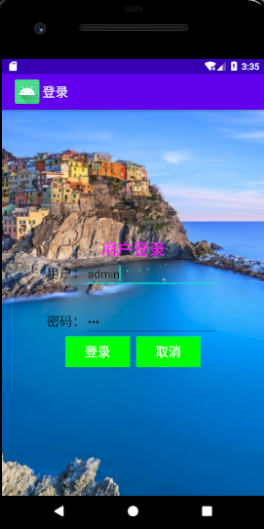
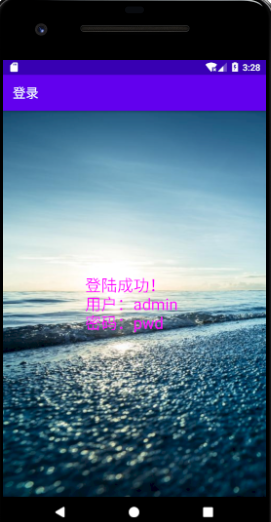
跳轉這一塊學起來真的很有意思(或許是因為視覺化可變動的原因),這一塊感覺並不是難主要是繁瑣;上面只說了封裝,主要是我有一種思維(或許大多數人都有)–資料封裝更專業,更安全。封裝的邏輯也很清晰。